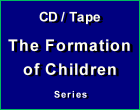Formation of Children
 |
 |
 |
 |
 |
 |
 |
Talking Tom and Friends:
Not a Conservative Innocent Show
Dear TIA,
When I was still a Novus Ordo-ist and I had not discovered your website yet, I was a fan of Talking Tom and Friends. For me, the show was the best conservative cartoon because it did not feature LGBT characters (Tom and Ben are just best friends). I found all their morals good except Episode 25, Season 2, in which Angela, one of the characters becomes an occultist.
/A075_01T.jpg) As a traditionalist, I am not sure if there are revolutionary or progressivist laced messages in the show.
As a traditionalist, I am not sure if there are revolutionary or progressivist laced messages in the show.
Should I recommend this show for young children? I would like to have an article of this on your site.
I remember Our Lady of Good Success predicted that the youth will be corrupted by bad shows.
Thank you,
R.R.
TIA responds:
Dear R.R.,
/A075_02T.jpg) Unfortunately, like many, if not all, modern children’s television shows Talking Tom and Friends does not contribute to a good formation.
Unfortunately, like many, if not all, modern children’s television shows Talking Tom and Friends does not contribute to a good formation.
On the contrary, it fosters vulgarity, egalitarianism and worldliness without any glimpses of innocent marvel or wonder. Although it may appear conservative compared to the extremely liberal television shows and cartoons being promoted today, it is in reality undermining a child’s conservative values.
Talking Tom and Friends, as the name implies, centers around Tom – a cat – and his three male friends, Ginger the cat and the two dogs Hank and Ben. Intermixed with this group is Angela, a white cat who becomes Tom’s romantic partner and spends most of her time with “the boys.” Strangely, Ginger is supposed to be a boy cat, but he is voiced by an actress, Maria Bamford.
According to the movie review website IMDb, the plot of the show is the following: “Armed with technological gear, great ideas and an unfailing sense of humor, Talking Tom and his friends are on a mission to reach stardom at all costs.” This brief description gives a perfect outline of the problems with the show.
Drawing children into a virtual world
/A075_03T.jpg)
/A075_04T.jpg)
/A075_Chi.jpg) Tom and his friends are “armed with technological gear”: in fact, they play with technology far advanced from what is known today, looking forward to a future world of robots and the digital sphere. Using modern technology to do all sorts of things as yet unimaginable, such as time-travel, mind-control, holograms, and entering alternative universes, the characters encourage children to spend all day in virtual reality and even desire to enter it, for every need is supplied in the virtual world.
Tom and his friends are “armed with technological gear”: in fact, they play with technology far advanced from what is known today, looking forward to a future world of robots and the digital sphere. Using modern technology to do all sorts of things as yet unimaginable, such as time-travel, mind-control, holograms, and entering alternative universes, the characters encourage children to spend all day in virtual reality and even desire to enter it, for every need is supplied in the virtual world.
In this television show, life is centered around the cell phone. Tom and his friends spend hours texting, watching videos, posting on social media and playing immersive apps. The cell phone plays such a predominant role in the show that Tom’s goal in life is to create an app that will make him famous.
Children who watch the characters constantly connected to the virtual world will imitate what they see and spend countless hours idling away time on their own devices, besides the time is spent watching television shows like Talking Tom.
Not only is such behavior endangering to the physical and mental health of the child, but it also is doing something far more menacing. The more time that a child spends before a digital screen, the less he will be able to distinguish reality from the artificial digital world.
As virtual reality is glorified, artificial intelligence is consequently more readily accepted, and children are being prepared to surrender their identities to technology and accept transhumanism (see here and here). Instead of inspiring children to see the beauty in the natural world God made for them, children are being encouraged to enter an ugly virtual world of speed, noise and agitation.
Children imitate what they see on screen
As Tom and his friends “hang out” together, they use the modern teenage jargon interspersed with the common interjection “like” – a clear indication that this show does not encourage children to speak well. On the contrary, they are taught to criticize and joke with their friends, disregarding proper manners by rude frankness.
/A075_07T.jpg)
/A075_Gri.jpg) Throughout the series, not one of the characters exhibits practices of virtue. Rather, anger and other vices are frequently laughed at and applauded. Bad music such as rapping and immodest dancing frequently appear on the screen, serving to further pervert the child’s mind.
Throughout the series, not one of the characters exhibits practices of virtue. Rather, anger and other vices are frequently laughed at and applauded. Bad music such as rapping and immodest dancing frequently appear on the screen, serving to further pervert the child’s mind.
The behavior of the characters is also exaggerated to the point of extreme vulgarity. For example, in one of the Minisodes Tom is shown playing ‘copycat’ with his friend: they proceed to put their fingers in their noses and stick out their tongues at each other. Both of these are only two examples of inappropriate behavior upheld as something funny and acceptable for children. Additionally, the characters act hysterically, at times making sporadic gestures, strange noises and ridiculous faces, as is also apparent in the above mentioned episode.
All of these points are unfortunately prominent themes in nearly every children's television show and have been shaping children since the advent of the first cartoon. From Sesame Street to the Flintstones to the Magic School Bus and so on, cartoons have been glorifying spontaneity, sarcasm, mimicry and discourteous – often even boorish – behavior. It would seem that the intention for having created such shows for children to watch again and again to the point of addiction was to pollute their minds and change their way of acting.
When observing children, one sees how readily they imitate everything they see or hear. Little children today are constantly presented with electronic entertainment, and, for this reason, many of them make unattractive and distorted expressions in imitation of their favorite characters on the screen. Parents need to be more cautious about what they allow their children to see, or they will soon find that they have no control over their little ones who act more like beasts than children.
Downplaying parents
/A075_08T.jpg) Another common theme in children’s television shows is the downplaying of the parents, which encourages disrespect. Either the parents are portrayed as stupid and ignorant, or no parents are presented at all. The message is clear: A young person cannot find fulfillment with his parents. He needs to break free from the old-fashioned restraints of home and family and devote his life to complete liberty with his worldly friends.
Another common theme in children’s television shows is the downplaying of the parents, which encourages disrespect. Either the parents are portrayed as stupid and ignorant, or no parents are presented at all. The message is clear: A young person cannot find fulfillment with his parents. He needs to break free from the old-fashioned restraints of home and family and devote his life to complete liberty with his worldly friends.
Talking Tom and Friends is the perfect example of such a message propagated through a television show: The entire plot involves “hanging out” with a group of friends who always support each other, in spite of their little disagreements and squabbles. To a child, this friend group becomes the ideal for his daily life, and he too will seek to spend time with his "cool" friends who play on their electronic devices without supervision.
Reaching stardom at all costs
Holy Writ wisely proclaims: What shall it profit a man, if he gain the whole world and suffer the loss of his soul? (Mk 8:36) Such a question never comes to the minds of Tom and his friends, who have no concept of living for a higher purpose other than self-enjoyment.
/A075_10T.jpg) As mentioned above, Tom’s goal in life is to invent an original app that will make him famous. Angela, in her turn, wants to be a superstar, though she is conflicted about whether to be a celebrity or a singer. Yes, Tom and his friends are attempting to "gain the whole world" by acquiring wealth and fame no matter what the cost. Right or wrong matters little so long as stardom is reached.
As mentioned above, Tom’s goal in life is to invent an original app that will make him famous. Angela, in her turn, wants to be a superstar, though she is conflicted about whether to be a celebrity or a singer. Yes, Tom and his friends are attempting to "gain the whole world" by acquiring wealth and fame no matter what the cost. Right or wrong matters little so long as stardom is reached.
Needless to say, the pursuit of stardom is contrary to the Catholic view of life. To present the glamour of the world as something to be sought after instead of rejected will lead children to also desire luxuries and fame instead of seeking to make sacrifices and save their souls.
Dating: An inevitable evil in cartoons
From the introduction of the first American cartoon with Walt Disney’s Mickey Mouse, cartoons have been promoting the concept of an unmarried couple who do everything together without making any commitments. One is inclined to think that such a relationship is innocent enough because it is sweet to see a feminine girl character and a boyish lad character fall in love.
/A075_11T.jpg)
/A075_12T.jpg) What this does, however, is subvert the principle of modesty between the sexes. The only reason two members of the opposite sex should spend long periods of time together – which should never be alone – is for the purpose of marriage. Additionally, the courtship period should not be too long, for the danger of impurity always accompanies such scenarios.
What this does, however, is subvert the principle of modesty between the sexes. The only reason two members of the opposite sex should spend long periods of time together – which should never be alone – is for the purpose of marriage. Additionally, the courtship period should not be too long, for the danger of impurity always accompanies such scenarios.
In complete disregard of these rules set by Catholic society of the past, cartoons favor the ready acceptance of non-committal dating even at a very young age. As a consequence, marriage is set aside as an unnecessary social contract.
The ultimate end of such disregard for marriage is the scandalous scenes played out in Talking Tom and Friends. Tom is continuously trying to romance Angela the cat, who dresses provocatively in short shorts, tight shirts, and so on. Throughout their love-life filled with breakups and reunions, Tom and Angela kiss and spend a lot of time together alone.
To make matters worse, in Season 1, Episode 23, Tom and Angela are “rooming together” with Tom’s other friends. In a typically absurd scenario, Tom’s old house is destroyed by a volcano, so he and his four male friends move in with Ginger and stay at her house for at least several episodes. Children watching this episode subconsciously learn that it is justifiable to have one girl living with four boys; as a result, they will see nothing wrong with a boyfriend and girlfriend living together or sharing dorm rooms later in life with persons of the opposite sex.
This is just one example of many such bad scenes intended to corrupt a child’s sense of purity.
Children’s television shows should be avoided
In conclusion, Talking Tom and Friends is far from innocent entertainment, but rather is a prime example of the errors of modern children’s entertainment. The question remains whether the problem of bad entertainment lies in the television itself. That perhaps is a topic for another article.
For now, it is best to ask the question whether or not there are any good television shows for children. We would have to truthfully say that we have never seen one that would correctly form the character of a child. Rather, all seem to have at least one of the characteristics of Talking Tom that will, as Our Lady of Good Success predicted, corrupt the minds of children and destroy their innocence.
Some criteria for good children’s entertainment will be addressed in a future article.
/A075_Beh.jpg) .
.

When I was still a Novus Ordo-ist and I had not discovered your website yet, I was a fan of Talking Tom and Friends. For me, the show was the best conservative cartoon because it did not feature LGBT characters (Tom and Ben are just best friends). I found all their morals good except Episode 25, Season 2, in which Angela, one of the characters becomes an occultist.
/A075_01T.jpg)
Should I recommend this show for young children? I would like to have an article of this on your site.
I remember Our Lady of Good Success predicted that the youth will be corrupted by bad shows.
Thank you,
R.R.
______________________
TIA responds:
Dear R.R.,
/A075_02T.jpg)
The cast: Ginger, Ben, Tom, Angela & Hank,
not good role models for children
On the contrary, it fosters vulgarity, egalitarianism and worldliness without any glimpses of innocent marvel or wonder. Although it may appear conservative compared to the extremely liberal television shows and cartoons being promoted today, it is in reality undermining a child’s conservative values.
Talking Tom and Friends, as the name implies, centers around Tom – a cat – and his three male friends, Ginger the cat and the two dogs Hank and Ben. Intermixed with this group is Angela, a white cat who becomes Tom’s romantic partner and spends most of her time with “the boys.” Strangely, Ginger is supposed to be a boy cat, but he is voiced by an actress, Maria Bamford.
According to the movie review website IMDb, the plot of the show is the following: “Armed with technological gear, great ideas and an unfailing sense of humor, Talking Tom and his friends are on a mission to reach stardom at all costs.” This brief description gives a perfect outline of the problems with the show.
Drawing children into a virtual world
/A075_03T.jpg)
Tom and friends emerged in the virtual world, below, Tom constantly on his cell phone
/A075_04T.jpg)
Below, children immersed in cell phones, like Tom and friends...
/A075_Chi.jpg)
In this television show, life is centered around the cell phone. Tom and his friends spend hours texting, watching videos, posting on social media and playing immersive apps. The cell phone plays such a predominant role in the show that Tom’s goal in life is to create an app that will make him famous.
Children who watch the characters constantly connected to the virtual world will imitate what they see and spend countless hours idling away time on their own devices, besides the time is spent watching television shows like Talking Tom.
Not only is such behavior endangering to the physical and mental health of the child, but it also is doing something far more menacing. The more time that a child spends before a digital screen, the less he will be able to distinguish reality from the artificial digital world.
As virtual reality is glorified, artificial intelligence is consequently more readily accepted, and children are being prepared to surrender their identities to technology and accept transhumanism (see here and here). Instead of inspiring children to see the beauty in the natural world God made for them, children are being encouraged to enter an ugly virtual world of speed, noise and agitation.
Children imitate what they see on screen
As Tom and his friends “hang out” together, they use the modern teenage jargon interspersed with the common interjection “like” – a clear indication that this show does not encourage children to speak well. On the contrary, they are taught to criticize and joke with their friends, disregarding proper manners by rude frankness.
/A075_07T.jpg)
Exaggerated & vulgar expressions & behavior that children copy
/A075_Gri.jpg)
The behavior of the characters is also exaggerated to the point of extreme vulgarity. For example, in one of the Minisodes Tom is shown playing ‘copycat’ with his friend: they proceed to put their fingers in their noses and stick out their tongues at each other. Both of these are only two examples of inappropriate behavior upheld as something funny and acceptable for children. Additionally, the characters act hysterically, at times making sporadic gestures, strange noises and ridiculous faces, as is also apparent in the above mentioned episode.
All of these points are unfortunately prominent themes in nearly every children's television show and have been shaping children since the advent of the first cartoon. From Sesame Street to the Flintstones to the Magic School Bus and so on, cartoons have been glorifying spontaneity, sarcasm, mimicry and discourteous – often even boorish – behavior. It would seem that the intention for having created such shows for children to watch again and again to the point of addiction was to pollute their minds and change their way of acting.
When observing children, one sees how readily they imitate everything they see or hear. Little children today are constantly presented with electronic entertainment, and, for this reason, many of them make unattractive and distorted expressions in imitation of their favorite characters on the screen. Parents need to be more cautious about what they allow their children to see, or they will soon find that they have no control over their little ones who act more like beasts than children.
Downplaying parents
/A075_08T.jpg)
The same exaggerated expressions on
the Sesame Street puppets
Talking Tom and Friends is the perfect example of such a message propagated through a television show: The entire plot involves “hanging out” with a group of friends who always support each other, in spite of their little disagreements and squabbles. To a child, this friend group becomes the ideal for his daily life, and he too will seek to spend time with his "cool" friends who play on their electronic devices without supervision.
Reaching stardom at all costs
Holy Writ wisely proclaims: What shall it profit a man, if he gain the whole world and suffer the loss of his soul? (Mk 8:36) Such a question never comes to the minds of Tom and his friends, who have no concept of living for a higher purpose other than self-enjoyment.
/A075_10T.jpg)
Angela, intent on stardom at all costs
Needless to say, the pursuit of stardom is contrary to the Catholic view of life. To present the glamour of the world as something to be sought after instead of rejected will lead children to also desire luxuries and fame instead of seeking to make sacrifices and save their souls.
Dating: An inevitable evil in cartoons
From the introduction of the first American cartoon with Walt Disney’s Mickey Mouse, cartoons have been promoting the concept of an unmarried couple who do everything together without making any commitments. One is inclined to think that such a relationship is innocent enough because it is sweet to see a feminine girl character and a boyish lad character fall in love.
/A075_11T.jpg)
Mickey & Minnie, not such an innocent romance; below, Tom & Angela, even less so
/A075_12T.jpg)
In complete disregard of these rules set by Catholic society of the past, cartoons favor the ready acceptance of non-committal dating even at a very young age. As a consequence, marriage is set aside as an unnecessary social contract.
The ultimate end of such disregard for marriage is the scandalous scenes played out in Talking Tom and Friends. Tom is continuously trying to romance Angela the cat, who dresses provocatively in short shorts, tight shirts, and so on. Throughout their love-life filled with breakups and reunions, Tom and Angela kiss and spend a lot of time together alone.
To make matters worse, in Season 1, Episode 23, Tom and Angela are “rooming together” with Tom’s other friends. In a typically absurd scenario, Tom’s old house is destroyed by a volcano, so he and his four male friends move in with Ginger and stay at her house for at least several episodes. Children watching this episode subconsciously learn that it is justifiable to have one girl living with four boys; as a result, they will see nothing wrong with a boyfriend and girlfriend living together or sharing dorm rooms later in life with persons of the opposite sex.
This is just one example of many such bad scenes intended to corrupt a child’s sense of purity.
Children’s television shows should be avoided
In conclusion, Talking Tom and Friends is far from innocent entertainment, but rather is a prime example of the errors of modern children’s entertainment. The question remains whether the problem of bad entertainment lies in the television itself. That perhaps is a topic for another article.
For now, it is best to ask the question whether or not there are any good television shows for children. We would have to truthfully say that we have never seen one that would correctly form the character of a child. Rather, all seem to have at least one of the characteristics of Talking Tom that will, as Our Lady of Good Success predicted, corrupt the minds of children and destroy their innocence.
Some criteria for good children’s entertainment will be addressed in a future article.
/A075_Beh.jpg) .
.
TV shows do not form serious, innocent children

Posted August 14, 2023
______________________
______________________











